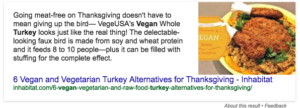Table of Contents
Are you looking to increase Click-Through Rates (CTR’s) to your site from search engines? Before jumping straight to spending more on ads or doing massive rewrites on meta descriptions, there is one area you should spend some time working on: title tags.
Some of the more important aspects of on-page optimization for as long as SEO have been a thing are title tags, meta descriptions and alt text. In terms of SEO, title tags matter – but it can also positively or negatively impact your CTR.
What are title tags?
Time for a breakdown. The HTML title element (otherwise known as a title tag) is one of the most important components of a web page when considering search engine rankings. These “tags” are written to describe the content on the pages they are titles for, and the search engines (sometimes, but not always) use them in the search results like so:

It is best practice to include the primary keyword you wish to rank for as well as your brand name. In this example you can see “Roast a Turkey” prominently in the title tag along with Butterball’s brand name.
When it comes to the length of your SEO optimized title tag, keeping it between 50 – 60 characters is best, because Google truncates titles that exceed their 600 pixel (or roughly 50-60 character) containers.
Related Content:
In the early days of the web, the best way to rank well was to jam as many keywords as you could into the title tag. And while this achieved great rankings, a title tag like “Best mashed potatoes, how to mash potatoes, mash potatoes” was/is abysmal from a user-experience perspective.
So, now we focus on creating super enticing title tags that also include keywords. It gives the search engines what they want and attracts the user’s attention as well; a win-win.
A real world example
A client of ours was interested in increasing the CTR of a particular blog post that was rising in the rankings, but simultaneously experiencing abysmal CTRs. The keyword they were ranking for on page 1 was highly competitive with a MSV of 14,800 and competitive results from quality domains with strong Domain Authority (DA) over 80 and 90. These high quality sites exude trust signals to users who are familiar with them, making it difficult for other sites to move up based on their strong DA’s and CTRs.
Not only that, but Page 1 of the SERPs was cluttered with an answer box snippet and the “People Also Ask” accordion feature, drawing attention away from the results lower on the page.
Answer box snippet example:

“People also ask” accordion reature example:

So, after some digging we made the following suggestions:
Recommendation 1: With click-through improvement in mind, we suggested that the client adjust the title tag for the post – creating a more engaging snippet within the search results.
Recommendation 2: We also recommended a small meta description change to move the focus of the description to the first few words rather than the end, which could help pull people in more quickly and avoid truncation.

Results of how a good title tag increased CTR for our client
In the two weeks after our title and meta description changes were implemented, the following was achieved:
- CTR for that post more than doubled: from 0.9% to 2.05%
- The post became the 6th most visited on their blog. It had never cracked the top 10 before these adjustments.
- Downloads of the content on the updated page became the 2nd most downloaded content on the site.
The updated post became an organic visit and download (their primary goal) powerhouse. Even though the ranking did not change in the short term, the CTR most definitely did.
Just like a juicy turkey, a juicy enticing title tags can really draw a crowd in. So don’t overlook it as you work to grow your organic traffic!
Search News Straight To Your Inbox
*Required
Join thousands of marketers to get the best search news in under 5 minutes. Get resources, tips and more with The Splash newsletter: